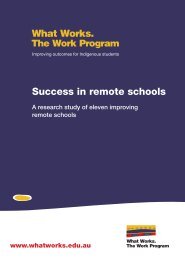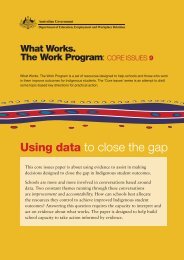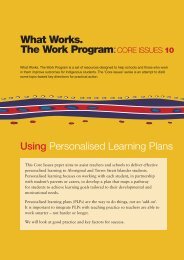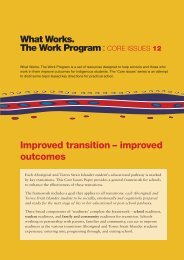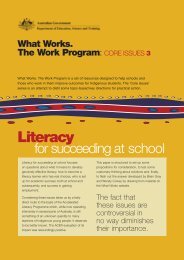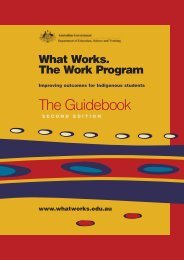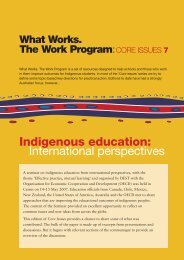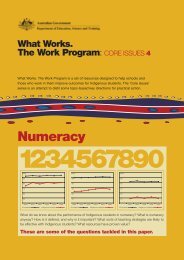Bound for Success Scope and Sequence Statements
Bound for Success Scope and Sequence Statements
Bound for Success Scope and Sequence Statements
- No tags were found...
You also want an ePaper? Increase the reach of your titles
YUMPU automatically turns print PDFs into web optimized ePapers that Google loves.
SCIENCEEnergy <strong>and</strong> ChangeConcept In Year 1the student:In Year 2the student:In Year 3the student:In Year 4the student:In Year 5the student:In Year 6the student:In Year 7the student:In Year 8the student:In Year 9the student:• Knows that magnetism is atype of energy <strong>and</strong> knowsthat pulling <strong>and</strong> pushingare different <strong>for</strong>ces of amagnet.• Knows that magnets exerta pulling <strong>for</strong>ce on someobjects but not on others.• Knows that magnets areused in different ways infamiliar objects where apulling <strong>for</strong>ce is needed(e.g. a fridge door latch orthe side of a torch).• Explores the idea thatsome <strong>for</strong>ces (e.g.magnetism) can act at adistance while others needto be in contact with theobject to affect it (e.g.shows using paper clips<strong>and</strong> magnets how anattraction <strong>for</strong>ce can existbetween the two objectswhen the magnet isn’ttouching the clip).• Knows the common uses ofmagnets in daily life• Knows that whencollisions occur friction isa <strong>for</strong>ce that acts to stopthings moving; it is acontact <strong>for</strong>ce (e.g. when amoving car collides with atree or another car thefriction stops themovement altogether).• Knows that some types ofsurfaces (including carpet,grass, cement, gravel <strong>and</strong>bitumen) slow movingobjects - such as a ball -more than others <strong>and</strong>compares the effect ofsurfaces, objects <strong>and</strong> othercircumstances.• Knows what magneticfields are• Knows the <strong>for</strong>ce ofmagnetism; that magnetsattract some materials <strong>and</strong>not others [ ∗ all metals aremagnetic”] <strong>and</strong> knowsThe Pole Law.• Knows about the earth’smagnetic field <strong>and</strong> howcompasses work.• Knows that friction is a<strong>for</strong>ce preventingmovement <strong>and</strong> that this isdetermined by surfacearea, nature of the surfacein terms of rough/smooth,<strong>and</strong> mass of an object.• Knows that friction can beincreased or reduced invarious ways <strong>and</strong> that thiscan be useful in everydaylife (e.g. <strong>for</strong> maximizinggrip on a tennis racquet orshoes, or using lubricantsin machinery to reducewear).• Knows how a magnet canbe made from an electriccurrent using a solenoid.• Considers <strong>and</strong> describeseffects on the motion <strong>and</strong>energy of objects insituations where several<strong>for</strong>ces are acting. Knowsthat <strong>for</strong>ces rarely act inisolation <strong>and</strong> usually act inpairs. Represents <strong>for</strong>cesdiagrammatically usingvectors to show where<strong>for</strong>ces are balanced <strong>and</strong> nomovement is occurring <strong>and</strong>where <strong>for</strong>ces areunbalanced resulting inmovement (e.g. <strong>for</strong>ces on aplane in flight, on a car orbicycle in motion, on aman running).• Knows how <strong>for</strong>ces such asweight <strong>and</strong> friction affectthe movement of an object(e.g. a person riding a bikedown a hill or child slidingdown a slide, how frictionis trans<strong>for</strong>med into heatenergy, <strong>and</strong> potentialenergy is transferred intokinetic energy as they slideor ride down).• Knows the principles ofdensity, volume <strong>and</strong> mass<strong>and</strong> uses Density =mass/volume to determinecomparative values <strong>for</strong>different substances.• Uses a measuring cylinderto compare the volumes<strong>and</strong> densities of objects inwater.• Knows the opposing <strong>for</strong>cesof buoyancy <strong>and</strong> upthrust<strong>and</strong> explain the flotation orotherwise of differentobjects including ships <strong>and</strong>razor blades).• Knows <strong>and</strong> describes theeffects of fluid friction(resistance) on objectsmoving through air orwater <strong>and</strong> how manattempts to overcome thesechallenges.∗ identifies common misconceptions in Science<strong>Bound</strong> <strong>for</strong> <strong>Success</strong> <strong>Scope</strong> <strong>and</strong> <strong>Sequence</strong> <strong>Statements</strong> V2 Page 55 Working Document Semester One 2007



